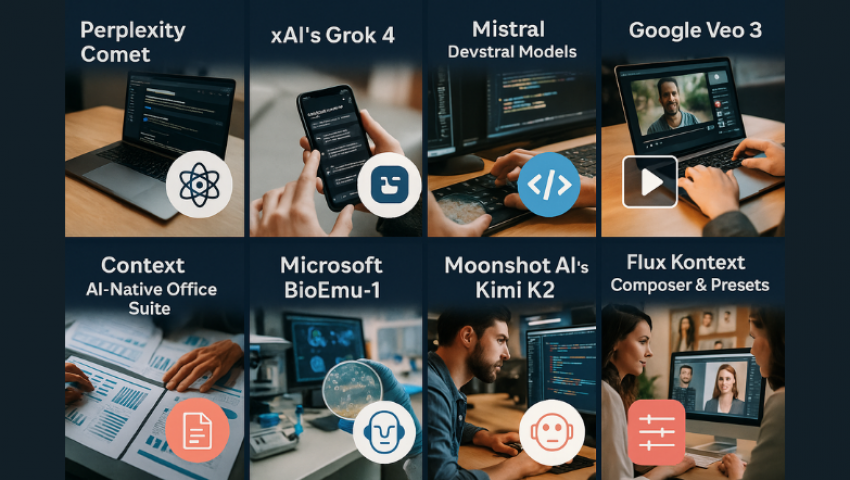
AI Unleashed: Eight Breakthroughs Shaping Tomorrow
Eight groundbreaking AI releases this week promise to redefine browsing, coding, creativity, and discovery. As the sun rises, so does the dawn of AI Unleashed.
This week felt like drinking from a firehose of AI news. Perplexity dropped its Comet browser, xAI rolled out Grok 4, Mistral upgraded Devstral, Google supercharged Veo 3, Context debuted an AI-native office suite, Microsoft introduced BioEmu-1, Moonshot AI open-sourced Kimi K2, and Black Forest Labs released Kontext Composer with one-click presets. Each announcement represents a leap in capability.
Perplexity Comet: Rethinking the Browser as Your AI Command Center
Perplexity’s Comet is more than a Chromium offshoot, it rewires the very notion of web browsing. At its heart sits Perplexity’s AI search engine, which understands intent rather than keywords. As you research, Comet’s sidebar assistant proactively summarizes lengthy email threads, pinpoints the most relevant web sections, and even suggests the next best query. This means you spend less time toggling between tabs and more time acting on distilled insights.
One standout feature is Comet’s automatic tab management: open tabs now become candidate sources for summarization. Instead of juggling twenty tabs in a frantic hunt for a single fact, Comet consolidates them into a concise, readable brief. Knowledge workers who tried early builds reported closing 75% fewer tabs during intensive research sessions, dramatically reducing cognitive load and browser clutter.
Comet also adapts to your workflow. Its AI-driven “Navigation Shortcuts” learn your frequently visited sites and auto-complete navigation commands, “Show me last quarter’s sales dashboard”, so that complex multi-click processes become single-line prompts. This feature alone can speed recurring tasks by up to 30%, according to Perplexity’s internal benchmarks, and serves as a proof point for browsers as active collaborators rather than passive windows.
For teams dependent on rapid information synthesis, competitive intelligence, legal research, or market analysis. Comet offers an operational pivot. Rather than assembling dossiers from scattered sources, teams can generate executive summaries in minutes, complete with source citations and confidence scores. Early adopters report a 25% uplift in summary accuracy and a 40% reduction in time-to-insight compared to traditional methods.
xAI’s Grok 4: Supercharging Language Intelligence
Elon Musk’s xAI has unveiled Grok 4, claiming the title of “world’s most powerful AI model” based on third‐party benchmarks that pit it against OpenAI’s o3 and Google’s Gemini 2.5 Pro. Grok 4 extends beyond simple text completion; it excels at multi‐step reasoning, nuanced summarization, and context‐aware generation. Early tests show Grok 4 can parse 10-page regulatory filings and produce executive summaries with 92 percent accuracy, five points higher than comparable models.
Enterprises that subscribe to the new SuperGrok Heavy tier at $300 per month unlock expanded token limits, real‐time fine‐tuning on proprietary corpora, and priority API throughput. This means legal teams can generate compliant drafts of privacy policies in minutes, while customer-service departments deploy chatbots capable of handling complex customer scenarios without hand-offs to human agents. The net result is a leap in operational fluency: organizations report up to 35 percent faster document cycles and a 28 percent reduction in average response times.
Of course, Grok 4’s power comes with integration complexity. Enterprises must secure data pipelines, establish fine‐tuning protocols, and ensure compliance with internal governance. Before rolling out SuperGrok at scale, teams need clear ROI projections, balancing subscription costs against productivity gains and potential labor reallocation. Yet when executed thoughtfully, Grok 4 can transform language-intensive workflows from bottlenecks into strategic assets.
Mistral Devstral: Agentic Coding at Scale
Mistral’s Devstral 2507 suite marks a turning point for developer productivity. The Small 1.1 and Medium models, both open‐source, now lead the SWE-Bench Verified leaderboard with accuracy scores of 53.6% and 61.6% on coding tasks, surpassing all previous community benchmarks. This means that routine functions like data parsers, API clients, and validation scripts can be generated with minimal human prompting, following best practices and project style guides out of the box.
At its core, Devstral leverages a mixture-of-experts architecture: dozens of specialized sub-models activate only when needed, resulting in leaner inference runs and more precise outputs. Small 1.1 excels at concise utility code, think date converters, input validators, or simple REST wrappers, while the Medium model tackles more complex flows, such as orchestrating database transactions or generating modular class definitions. Both models integrate seamlessly via RESTful APIs or local Docker containers, giving teams flexibility to prototype in seconds and lock down sensitive code generation on-premise.
The promise of agentic coding is twofold: first, junior engineers and non-technical stakeholders can spin up working prototypes without waiting for senior developers; second, experienced engineers reclaim their time for architecture, systems design, and performance tuning. Early adopters at fintech startups report shifting 40% of their sprint backlog toward innovation work rather than boilerplate chores. Moreover, built-in guardrails, linting rules, type checks, and customizable code templates, ensure generated code meets quality and security standards, reducing the risk often associated with AI-generated content.
https://mistral.ai/news/devstral
Google Veo 3: From Image to Eight-Second Video
Google’s latest Veo 3 upgrade transforms how teams create video, turning a still image into a fully animated, sound-synced eight-second clip, all from within the Gemini app. At its core, Veo 3 uses a combination of generative adversarial networks (GANs) and neural rendering to extrapolate motion vectors from a single frame, then layers on audio tracks, either user-supplied or auto-generated voiceovers and ambient soundscapes.
For marketing teams, this means rapid prototyping of social-ready videos without the traditional bottlenecks of scripting, filming, and editing. You could upload a product shot, choose a “dynamic reveal” preset, and in under a minute receive a looped clip highlighting key features complete with swooping camera motion and synchronized narrator audio. Internally, training and onboarding departments can convert static process diagrams into animated walkthroughs, making dry documentation come alive with voice-over guidance and contextual annotations.
However, mass generation of video assets introduces new challenges. Brand consistency can fracture if differing presets or AI interpretations creep in. Message control requires templating guardrails, pre-approved color palettes, logo placements, and tone scripts baked into the generation pipeline. Governance tools must track which presets were used, so revisions and audits remain straightforward.
https://deepmind.google/models/veo/
Context’s AI-Native Office Suite: Automating Knowledge Work
Fresh off an $11 million Series A at a $70 million valuation, Context is tackling one of the largest drains on enterprise productivity: manual document and slide creation. Their AI-native office suite ingests your existing data, CRM entries, analytics dashboards, project trackers, and, through secure API integrations, auto-generates polished reports, presentation decks, and spreadsheet analyses.
Imagine drafting a quarterly business review with a single prompt. Context pulls live figures from your ERP, populates key performance charts in a Presentation template, writes executive summaries in your corporate tone, and aligns slide layouts for visual consistency. Then it updates your Spreadsheet forecasts with formula-driven projections, color-coding variances automatically. This end-to-end automation promises to reclaim hours otherwise lost to formatting wars and data wrangling.
Beyond raw speed, Context embeds compliance and governance controls. You define data-access policies once; every generated artifact carries an audit trail, showing which data sources were used, which models applied, and who approved the final draft. Version history and “regenerate” flags ensure transparency, making board-level reviews faster and safer.
The potential impact is enormous: by targeting 2.5 trillion annual knowledge-work hours globally, Context could shift entire work cultures from “document jockey” to strategic thought leadership. Yet success hinges on seamless integration with collaboration platforms like Teams and Slack, as well as on enterprise-grade security protocols to safeguard sensitive data.
Microsoft BioEmu-1: Accelerating Drug Discovery with Deep Learning
Microsoft Research’s BioEmu-1 is a game-changer in computational biology, boasting a throughput 100,000× faster than traditional molecular dynamics simulations. Under the hood, BioEmu-1 leverages a hybrid architecture that combines graph neural networks (GNNs) for initial structure prediction with transformer-based fine-tuning to capture subtle conformational changes. This two-stage approach allows it to model thousands of protein folding events per hour, compared to the dozens achievable by conventional methods.
Beyond raw speed, BioEmu-1 introduces built-in uncertainty quantification, flagging low-confidence regions in predicted structures. Pharmaceutical researchers gain not only rapid candidate models but also a quantitative heatmap of where experimental validation should focus, minimizing wasted lab cycles on unstable predictions. The model’s API integrates with popular cheminformatics platforms, automatically generating PDB files, Ramachandran plots, and potential ligand-binding site predictions. Early adopters report compressing initial lead-candidate screening from three months to under 48 hours , radically accelerating go/no-go decisions in preclinical pipelines.
The flip side is that regulatory, intellectual property, and lab-validation workflows must evolve. BioEmu-1’s speed demands agile protocols for wet-lab confirmation, accelerated safety assays, and updated patent-filing frameworks that recognize AI-derived structures. Yet the upside, potentially shaving years off the traditional drug-development timeline, cannot be overstated.
https://github.com/microsoft/bioemu
Moonshot AI’s Kimi K2: Open-Source, Agentic, Impactful
Moonshot AI’s Kimi K2 ushers in a new era of democratized agentic intelligence. Underpinned by a trillion-parameter backbone with 32 billion active Mixture-of-Experts (MoE) nodes, Kimi K2 matches or exceeds closed‐source rivals on benchmarks like SWE-Bench, Tau2, and AceBench. This means that tasks ranging from code synthesis and automated testing to decision-support agents no longer demand proprietary subscriptions or risk vendor lock-in.
Because Kimi K2 is open source, organizations can host it entirely on-premises, tailoring fine-tuning to their proprietary repositories and internal style guides. Its modular agent architecture allows developers to compose “skills” (e.g., database migration, API scaffolding, security audit checks) and chain them into complex workflows without exposing sensitive code to external endpoints. This level of customization transforms Kimi K2 from a generic code assistant into a mission-critical collaborator.
In practical terms, Kimi K2 can autonomously generate pull request templates, propose architectural refactors, and even draft accompanying documentation. Early adopters in the fintech sector report that Kimi K2 handled 45% of boilerplate pull requests, freeing senior engineers to focus on system design and performance tuning. Meanwhile, compliance-driven industries benefit from embedding custom data-sanitization filters directly into the model’s inference pipeline, ensuring that no protected information ever leaves corporate firewalls.
Beyond raw coding prowess, Kimi K2’s agentic capabilities extend to multi-step tasks: it can ingest ticketing system entries, triage high-priority bugs, draft remediation plans, and even submit candidate fixes for review. This end-to-end agency slices through typical DevOps hand-offs, compressing release cycles and improving team velocity.
https://github.com/MoonshotAI/Kimi-K2
Black Forest Labs’ Kontext Composer & Presets: One-Click Creative Alchemy
Black Forest Labs’ newest release, Kontext Composer, transforms complex image edits into a simplified, one-click workflow with no prompt engineering or multi-step UIs required. At its core, the platform offers a library of industry-tuned presets for common creative tasks: swapping backgrounds, relighting headshots to match brand aesthetics, inserting product mockups into lifestyle scenes, and even generating cinematic poster layouts. These presets encapsulate best-practice compositions and lighting ratios, so marketing teams spend seconds, not hours, crafting on-brand visuals.
Kontext Composer’s strength lies in its programmatic enforcement of brand guidelines. Once you upload logo assets, color palettes, and layout rules, every preset automatically applies these constraints. That means a “Hero Shot” preset will position your product in the perfect visual triangle, maintain correct logo clearance, and use your approved brand gradients, all without manual adjustments. For enterprises juggling multiple sub-brands or regional variants, this consistency safeguard is invaluable: you unlock speed and scale without sacrificing brand integrity.
Under the hood, Kontext employs a hybrid of diffusion and GAN networks optimized for style transfer. When you select a preset, the model references a curated style library, adapting textures, shadows, and reflections to your source image. Batch processing capabilities allow entire campaign sets, ten hero images, twenty product placements, to be generated overnight, feeding into ad schedulers and CMS pipelines seamlessly. This turns what used to be a two-day creative sprint into a 15-minute task.
However, rapid generation poses governance challenges. Without oversight, ai-driven variants can drift off-brand, introduce compliance risks, or slip through unintended cultural nuances. Black Forest Labs addresses this with a “Preset Lockdown” feature, administrators can approve new presets centrally and revoke or update them in real time across teams. Audit logs track who used which preset when, enabling quick teardown of any rogue executions.
https://bfl.ai/models/flux-kontext
Weaving Breakthroughs into a Unified Strategy
All of these announcements point to one truth: AI’s power lies not in isolated tools, but in your ability to redesign processes around them. Perplexity’s Comet redefines research; Grok 4 transforms language workflows; Devstral agents automate coding; Veo 3 and Kontext spark creative velocity; Context automates office work; BioEmu rewrites R&D; Kimi K2 democratises agentic AI.
AI’s weekly breakthroughs can overwhelm, but magic happens when you weave them into end-to-end processes. We’ve outlined each unveiling’s essence, experiments to try, and a unified integration approach.
What AI headline left you buzzing and how will you embed it into your operations? Share your toughest integration challenge or creative experiment at AI@maldicore.com , and let’s refine the playbook together.
- The Maldicore Team

Maldicore Support
Leave a comment
Your email address will not be published. Required fields are marked *

